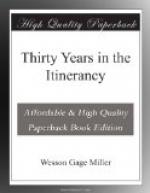During the pastorate of Brother Wilson an unhappy controversy arose between the managers of the Sunday School and the leaders of the social means of grace with reference to the hours of meeting. The Official Board decided in favor of the School, and an alienation of feeling was the result. A few of the disaffected withdrew, organized a Wesleyan Church, and called Rev. Mr. McKee as their Pastor. Though an unpleasant affair, the old church moved on as usual.
But as another charge was now growing up in the southern part of the city, it is proper that I should refer to it before closing this chapter.
In the fall of 1847 Osmond Bailey and a few others became specially interested in establishing regular religious services at Walker’s Point. Soon after a class was formed consisting of Mr. and Mrs. Osmond Bailey, Mrs. Capt. Stewart, Mrs. Warren. Mrs. Almena Waite, Mrs. Worden, Mr. and Mrs. Daniel Waite and M.S. Velie.
At the Conference of 1848, the small society was erected into a Mission with Rev. Warner Oliver as Pastor. The Meetings were held in a school house, located on lots eleven and twelve, in block one hundred and one.
Brother Oliver was a man of fine talent, but was compelled to give a portion of his time to business, through the financial feebleness of the charge.
In 1849 Rev. William Willard was appointed to the charge. It will be remembered that this good brother was a member of the class formed at Burnett in 1845. He entered the Conference in 1847, and had been stationed two years at Aztalan. He was an earnest laborer, and under his administration the work was encouragingly prosperous. The congregations were growing and the people were beginning to agitate the measure of building a Church.
After leaving Walker’s Point, Brother Willard remained in the regular work, with a few brief intervals, for many years, doing efficient service for the Master. At this writing he is in Nebraska, using such openings as may offer to help forward the good work.
Hiving thus briefly sketched the beginnings and progress of the good work in the city up to the time of my appointment, I will defer the balance of the record for the next chapter.
CHAPTER XI.
Spring Street, Milwaukee—First Sabbath—Promising Outlook—The Deep Shadow—Rev. Elihu Springer—Rev. I.M. Leihy—Revival—Missionary Meetings—Dedication at Sheboygan—Ravages of the Cholera—Death-bed Scenes—The Riot—Bishop Waugh—Camp Meeting—Scandinavian Work—Rev. C. Willerup.
The Spring Street Station had now attained the reputation of being the first charge in the Conference. The Church edifice, as we have seen, was decidedly respectable, both in size and character. The membership was enterprising, and full of the spirit of labor. In its official Board were found L.S. Kellogg, G.F. Austin, John H. Van Dyke, Geo. E.H. Day, James Seville, J.C. Henderson, W.W. Lake, Wm. Rowbotham, George Southwell, Wm. R. Jones, Wm. L. Boughton, John Kneene, Wm. Cossentine, C.F. Larigo and Charles Randall. And during the year John Kemp, Cornelius Morse, Mitchell Steever, C.C. Chamberlin and Henry Seiler were added.




